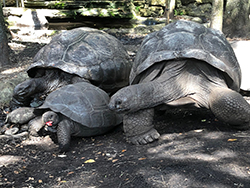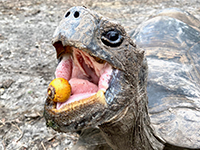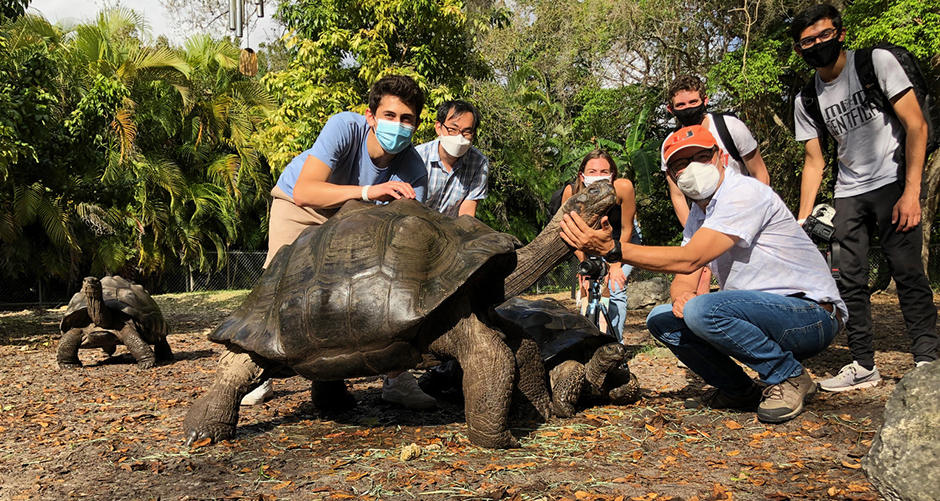Thousands of years ago, the Caribbean islands were replete with giant tortoises, macaws, monkeys, iguanas, and fruiting trees. Between overdevelopment, climate change, sea level rise, and other environmental insults, today’s Caribbean bears a pale resemblance to its lush and diverse prehistoric past.
While the clock cannot be turned back, a biologist with the College of Arts and Sciences is taking steps toward restoring these rich island ecosystems through “Rewilding the Caribbean,” a collaborative initiative with long-term implications for the entire Western Hemisphere.
 “High rates of animal extinctions have massively disturbed the Caribbean islands,” says Mauro Galetti, associate professor of biology and director of the John C. Gifford Arboretum. “These extinctions have far-reaching consequences for the survival of plant populations.
“High rates of animal extinctions have massively disturbed the Caribbean islands,” says Mauro Galetti, associate professor of biology and director of the John C. Gifford Arboretum. “These extinctions have far-reaching consequences for the survival of plant populations.
“They may ultimately lead to a collapse of important ecosystem functions such as carbon storage, which mediates the impact of greenhouse gases.”
Over the past 7,000 years, at least ten species of giant tortoises, four species of primates, several species of macaws, and ten species of giant sloths have become extinct due to human poaching and habitat loss. “The loss of the giant tortoises is particularly devastating, because they are frugivores, eating fruits and distributing the seeds throughout their habitats,” says Galetti.
CLICK HERE TO GET A BEHIND-THE-SCENES LOOK AT DR. GALETTI'S RESEARCH.
Turning the Tide
To bring back some of the Caribbean’s lost biological diversity, Galetti has launched a pilot project studying the role of giant tortoises in the germination of Caribbean plants. “The Caribbean is ideal for rewilding,” he notes, “because there are so many islands where small populations of animals could be reintroduced and studied in a controlled environment.”
Genetically and functionally similar to their extinct cousins, Galapagos tortoises have gaping mouths that allow them to swallow large fruits and deposit the seeds throughout their habitat.
“Several plant species in the Caribbean evolved large fruits too big to be eaten by birds, and they were possibly dispersed only by giant tortoises,” Galetti says. “Seed dispersal by animals plays a prominent role in maintaining healthy tropical vegetation. In fact, 90 percent of all trees in the South American rainforest rely on vertebrates to spread their seeds.
“When the animals become extinct, plant populations can become confined to limited areas and lose their genetic diversity, making them vulnerable to changing climate conditions.”
 Fruits of Their Labor
Fruits of Their Labor
To begin the rewilding project, Galetti and his students measured living birds and rock iguanas as well as fossils of extinct Caribbean tortoises in the University of Florida Natural History Museum in Gainesville. Next, the team studied the size, shape, and structure of a variety of tropical fruits from the Gifford Arboretum, Montgomery Botanical Center, and Fairchild Tropical Botanical Garden—“something like matching a key to a lock,” says Galetti.
After identifying several types of large-seeded fruit that have grown in the Caribbean for thousands of years, Galetti and his students began feeding these fruits to Galapagos tortoises, standing in as extinct Caribbean extinct giant tortoises. “We are extremely grateful to the Three Jays Tortoise Sanctuary and the Grossman family, who kindly allow us to feed their Galapagos tortoises with the Caribbean fruits,” he says.
The team found that the fruit seeds that pass through the guts of a Galapagos tortoise germinate much faster than those that just land on the ground.
“For instance,” Galetti says, “the Cuban belly palm seed takes at least two years to germinate in the wild, but it can begin growing in just four weeks after being swallowed and dispersed by a tortoise. That’s a clear indicator of the importance of animals in maintaining healthy plant populations.”
This summer, Galetti is planning a field trip to some Caribbean islands with both graduate and undergraduate students to scout potential locations for the rewilding initiative. “Rewilding is a powerful tool for nature restoration and climate change mitigation,” he says. “We need an ideal ‘laboratory’ to execute our project, and the islands are perfect for that.”
Broadening the Focus
Rewilding the Caribbean involves more than just reintroducing tortoises to the islands. Another candidate for increasing biodiversity is the blue and gold macaw, now found in limited numbers in South Florida. It is genetically similar to extinct species of these large, colorful birds that were once plentiful in the islands.
“The Caribbean was home to several macaw species, but none of them survived,” Galetti says. “We have been studying the feeding habits of the macaws that live in Coral Gables to see if they would be good candidates to replace the ecological functions of the extinct macaws.
“By using remote-controlled cameras, we can see what fruits they eat and whether they drop those seeds immediately or carry them away to other locations. This will help us understand their diets and whether an island habitat would support a small population of macaws over the long term."
Galetti also plans to study the rock iguana, one of the few large animals remaining in the Caribbean. Threatened by poachers, the endangered species can be found on just a handful of undeveloped islands in the Caribbean. With proper protection, this iguana can also contribute to restoring biodiversity.
The potential benefits of Galetti’s research, with its collaborative embrace of citizen science, research institutions, and botanical gardens, reach beyond the Caribbean. “In the past, many types of large animals and plants thrived together,” he says. “Understanding the interactive relationships between animals and plants is vital to increasing the biodiversity resilience in a variety of tropical and subtropical habitats.
“Our rewilding initiative could serve as a model for restoring the natural balance not only of the Caribbean Islands, but many other endangered ecosystems.”
Alumnus Gift Will Enhance Arboretum
UM’s John C. Gifford Arboretum is a destination not only for education and research, but reflection and relaxation. A generous gift from Eric D. Brueggeman, A.B. ’13, will help revitalize the facility with new benches, an easily accessible path, water fountains, and other features.
“This wonderful gift will transform the Arboretum, creating a ‘must-see’ natural campus site for ’Canes and the community,” Galetti says.
Last fall, College of Engineering student teams, supervised by Associate Professors Esber Andiroglu and Matthew Trussoni of the Department of Civil, Architectural and Environmental Engineering, crafted sustainable plans to attract more visitors to the arboretum. The students’ ideas include recycled rubber pathway, benches with solar panels, and outlets to power laptops or cell phones. An outdoor pavilion could serve as a classroom and feature a rooftop lounge for visitors to appreciate the surrounding greenery.
The students presented their projects to a group that included Andiroglu, Trussoni, and Galetti; Terri Hood, senior lecturer and assistant director for the undergraduate ecosystem science and policy program, who maintains the Arboretum’s Sustainability Garden; and Teddy L’Houtellier, the University’s sustainability manager.
The group will make recommendations to the Faculty Senate committee on facilities and planning, “We will discuss what we can implement from the students’ ideas in a way to keep the Arboretum tranquility, our plant collection and the visitors’ needs,” Galetti says.
Your donation can help our faculty conduct research and expand learning experiences for UM students. For more information, visit as.miami.edu/donate.

